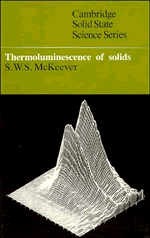Book contents
- Frontmatter
- Contents
- Preface
- 1 Introduction
- 2 Theoretical background
- 3 Thermoluminescence analysis
- 4 Additional factors governing thermoluminescence
- 5 Defects and thermoluminescence
- 6 Thermoluminescence dosimetry (TLD)
- 7 Thermoluminescence dating
- 8 Geological applications
- 9 Instrumentation
- Appendix A Minerals
- Appendix B Commercial thermoluminescence systems
- References
- Index
1 - Introduction
Published online by Cambridge University Press: 04 April 2011
- Frontmatter
- Contents
- Preface
- 1 Introduction
- 2 Theoretical background
- 3 Thermoluminescence analysis
- 4 Additional factors governing thermoluminescence
- 5 Defects and thermoluminescence
- 6 Thermoluminescence dosimetry (TLD)
- 7 Thermoluminescence dating
- 8 Geological applications
- 9 Instrumentation
- Appendix A Minerals
- Appendix B Commercial thermoluminescence systems
- References
- Index
Summary
What is thermoluminescence?
Volume 84 of the Physics Abstracts Subject Index for 1981 lists over 300 separate entries for papers concerning the topic of thermoluminescence. Bräunlich (1979) states that there are over 500 articles published per year on phenomena relating to thermoluminescence (generally termed thermally stimulated relaxations). Newcomers to this field and experienced research workers alike may find such a high rate of publication surprising. This response may be reinforced when they realize that, as an experimental technique, thermoluminescence finds favour in such diverse scientific disciplines as archaeology, geology, medicine, solid-state physics, biology and organic chemistry, to name just some of the mainstream areas of study. The reader may justifiably enquire what it is about thermoluminescence that makes it such a well-used experimental method, enjoying widespread popularity and displaying enormous versatility. The answer to this enquiry is the essential theme addressed in this book. To answer the question fully it will be necessary to illustrate how the thermoluminescence characteristics of a material relate directly to the material's solid-state properties and how these solid-state properties are being utilized in the diverse fields mentioned above. However, before delving into the detail necessary to answer the question in full an initial approach to the problem must be made by stating what thermoluminescence is.
Thermoluminescence is the emission of light from an insulator or semiconductor when it is heated. This is not to be confused with the light spontaneously emitted from a substance when it is heated to incandescence.
- Type
- Chapter
- Information
- Thermoluminescence of Solids , pp. 1 - 19Publisher: Cambridge University PressPrint publication year: 1985

